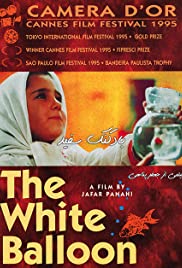
THE WHITE BALLOON
And, 1995, 83 minutes, Colour.
Aida Muhammadkhani.
Directed by Jafar Panahi.
In the 1990s, Iranian cinema had a very strong reputation worldwide. It had significant directors like a Abbas Kierostami and emerging directors like Majid Majidi and Jafar Panahi. Most of the films were comparatively small-scale, dramas, often in confined locations and, as with this film, a focus on young children. Majidi made Children of Heaven and Colour of Paradise.
The White Balloon is the first feature film, after documentary and short films, by Jafar Panahi who achieved international awards and acclaim during the 2000s. However, he clashed with the Iranian government, forbidden to make films for 20 years, under house arrest, but defying the authorities by finding ways to make small budget features and distribute them. And celebrated director, Abbas Kierostami produced this film.
It is a brief slice of life in Teheran, while there are sequences at home, much of the action is in the streets of the city and at the markets. We see family shopping, children playing, tailor, soldier, an old lady, snake charmers operating in the market.
However, the focus is on the seven-year-old girl who accompanies her mother to the market, as a special feast is announced on the radio. While they have fish at home in a bowl, the little girl is attracted to the fish at the market and continually asks her mother to buy some, the mother refusing. However, at home, with the mother very busy, the father present but having a clash with his son who has brought soap instead of shampoo, the mother gives in and gives the little girl some money. She accompanies her brother back to the market to buy the fish.
There are some episodes on the way, the encounter with the snake charmers who take her money but she is able to get it back. And then, she loses the money, it falling through a grate. And this is where people help her, and a boy with a white balloon, an Afghan refugee, helps with the recovery of the money, using a magnet tied onto his balloon.
The children get the money, buy the fish and run-off happily, forgetting all about the boy who helped them. However, they are children, not adults. So, the film is a portrait of young children, their charm, their whims, the self-preoccupation. (On the other hand, some commentators have seen it as a criticism of Iranian society and itself-preoccupation.)
1. The appeal of the film? Adults, children? Audiences identifying? Its classic status?
2. The reputations of the writer, the director? Uranian cinema in the 1990s?
3. Life in Teheran, the 1990s, the celebration of the feast, announcements on the radio, the market, the fish in the sales, family life, the vendors, life in the city? The musical score?
4. Razieh 7, audience response to the young actress, her vitality? Delighting in her? Yet her nagging, self-focus? Wanting the fish, continually asking? Her relationship with her parents, her father and criticisms? The mother being busy? Her brother? The fish at home, wanting the new fish? Getting the money? The encounter with the snake charmers, the taking of the money? The encounter with the tailor, the soldier, the old lady? Her help with the money? Razieh losing the money twice, recovery, down the drain? The Afghan boy, the balloons, the last balloon left, the white balloon, the magnet, getting the money back? The children running off without regard to the boy? The boy left alone with his balloon?
5. The realism of the story, the symbolism of the story? The children, self-centredness? The loan Afghan?
6. The market, vibrant, the many vendors, the mother in the shopping, Razieh and the fish, the various pleas? Going home, the continued tanking, her mother eventually giving in?
7. Her brother, his relationship with the father, the father snapping, throwing the soap, the buying of the shampoo, going with his sister to get the fish?
8. The various buying escapades, the snake charmers and their work, their personalities, the money, the range of ordinary people along the way of the escapade?
9. The great, the help, the boy with the balloon?
10. The children running away, the boy left?